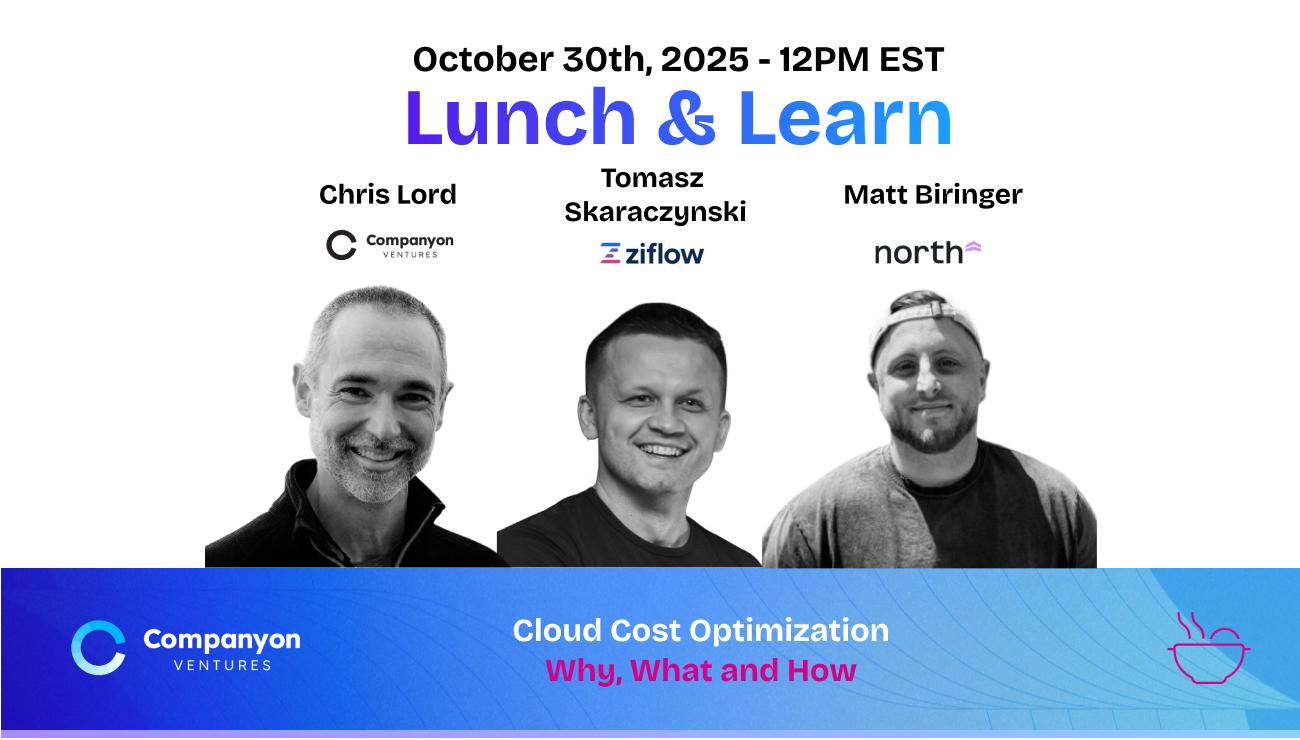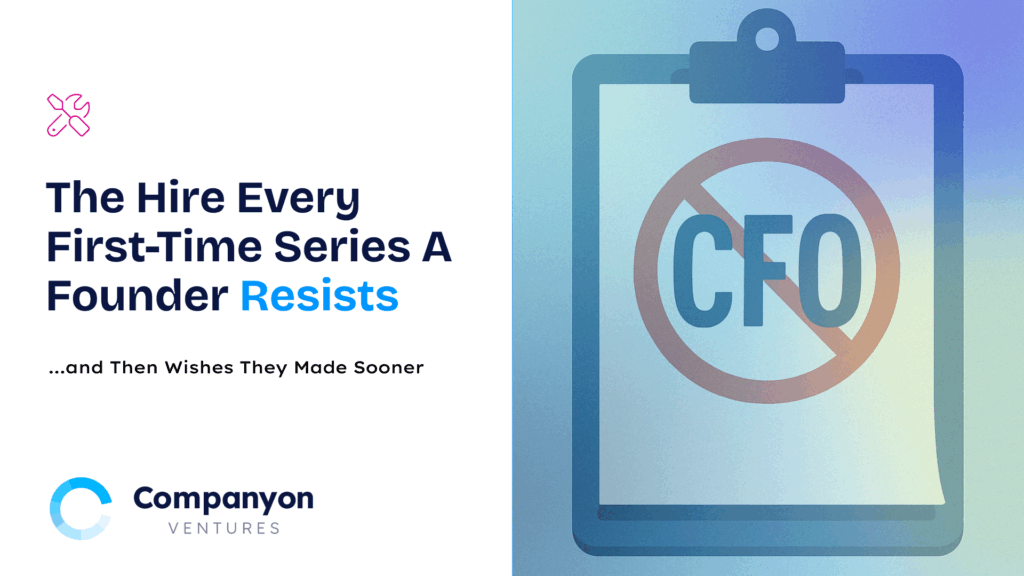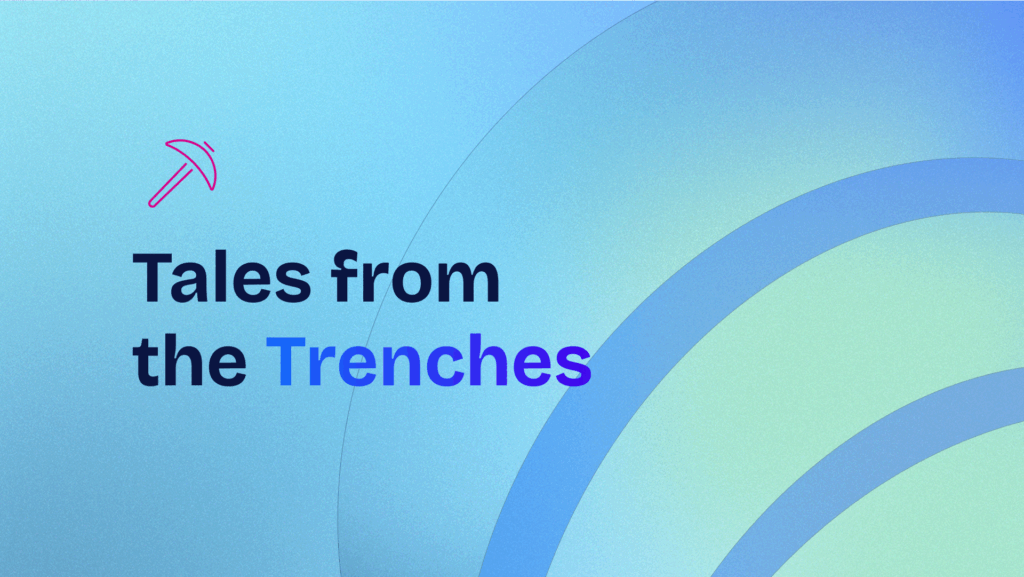


Cloud Cost Optimization—Why, What and How
 Cloud costs are the silent killer of early-stage runway and revenue growth. Over half of all organizations waste more than 30% of their total cloud spend—and for AI startups, those costs can consume 40-60% of the entire technical budget before the first customer is onboarded.
Cloud costs are the silent killer of early-stage runway and revenue growth. Over half of all organizations waste more than 30% of their total cloud spend—and for AI startups, those costs can consume 40-60% of the entire technical budget before the first customer is onboarded.
At Companyon’s Lunch & Learn, Venture Partner Chris Lord brought together Matt Biringer, CEO & Founder of North, and Tomasz Skaraczynski, CTO at Ziflow, to unpack how founders can control cloud spend before it controls their business.
Here are the biggest takeaways:
Start with Visibility, Not Optimization
Tomasz was emphatic. You can’t control what you don’t measure. Before worrying about reserved instances or spot pricing, founders need enforced cost tagging across projects and teams, real-time dashboards, and spend alerts.
At Ziflow, the engineering team uses cost allocation tags to understand the daily impact of new features in early phases—not after a month when the damage is done. This gives engineers real-time cost visibility and helps them understand the business impact of their architectural decisions.
👉 Tomasz’s advice: set up daily spending alerts based on tags or services. When you experiment with a new feature or deploy to production, you’ll know immediately if you’re burning cash—not 30 days later when the bill arrives.
Don’t Train Your Own Model Until You’ve Validated with Off-the-Shelf
For AI startups, GPU costs are the elephant in the room. But Tomasz challenged a common assumption: do you really need to train your own model? Ziflow initially believed their data was so unique that they needed specialized models. But after evaluating AWS Bedrock, brand recognition services, and eventually testing with Gemini 2.5 and ChatGPT, they discovered pre-trained models delivered excellent results at a fraction of the cost.
👉 The recommendation: validate your hypothesis with GPT, Claude, or other pre-trained models first. You can control costs easily, swap models as needed, experiment with mini versions, and stay model-agnostic. Only invest in custom model training once you’ve proven that off-the-shelf solutions can’t meet your requirements.
Build for Elasticity from Day One
Should you architect for spot instances and interrupted workloads from the beginning, or is that premature optimization? Tomasz’s answer was clear: Ziflow was fortunate. They built on a microservices architecture from the start, communicating via queues between systems, so workflows could be interrupted and resumed easily. This architectural decision allowed them to leverage spot instances and auto-scaling clusters that adapt to training demands—paying only for compute that delivers value.
👉 For founders: the different types of cloud resources (on-demand, reserved, spot) should inform your design and architecture phase. If you’re building an AI startup, make sure your workloads can tolerate interruption and resumption. That single architectural decision can slash GPU costs by 60-80%.
Cloud Cost Optimization Is a Value Creation Strategy, Not Cost Cutting
Cloud cost optimization isn’t short-term cost-cutting—it’s a lever for strategic flexibility and fuel for growth. The savings translate directly into:
- Increased EBITDA: healthier financials make you more attractive to investors
- Extended runway: operate longer without additional financing
- Reinvestment opportunities: redeploy savings into product development, talent acquisition, or marketing
At one consulting engagement, Tomasz found a company paying $1 million annually for S3 buckets without any lifecycle policies in place. After three months of implementing data lifecycle rules, they saved 70% of that spend.
👉 Frame optimization wins as strategic impact: “What more can we achieve with the resources we free up?”
The Right Time for a Tool Like North: Five Figures per Month
Matt was candid about when automation platforms like North make sense. If you’re spending a couple thousand dollars per month and still burning through cloud credits, optimization won’t move the needle.
👉 The threshold: once you hit five figures per month in cloud spend, optimization savings become material enough to reinvest—whether that’s hiring developers, scaling the team, or funding go-to-market activities.
FinOps Is a Cultural Practice, Not Just a Finance Function
Matt described the inevitable tension between finance and engineering as companies scale. Finance teams manage P&L, hiring costs, and investor relations—they don’t have time to understand the difference between convertible and standard reserved instances. Meanwhile, engineering teams often adopt a “this is my environment, don’t go near it” attitude, fearing that finance will bombard them with questions they don’t want to answer.
👉 The solution: software that acts as a bridge between these two practices. North is building features specifically to address this cultural gap:
- Permission-based access: CTOs can give finance teams visibility into specific pages or data without overwhelming them with technical noise they don’t need
- Agent North (AI assistant): Finance leaders can Slack a bot specialized in cloud spending data and get answers in layman’s terms—without bothering the technology team
Don’t Ignore the GM Warning Signs
Chris shared a cautionary tale from his previous startup. Their goal was to maintain 80% gross margins, which they achieved for quite a while. However, when margins dropped to 60%, alarm bells began to ring.
The culprits were familiar: running two parallel cloud infrastructures during a customer migration, accumulating compute costs from data science experiments without right-sizing, and retaining massive amounts of checkpoint data they didn’t realize was piling up.
👉 The lesson: there’s no magic percentage, but if your gross margins are trending downward and cloud costs are the driver, it’s time to act. Chris’s team got back above 80% gross margins by migrating customers, re-architecting workflows, and productizing R&D experiments in cost-efficient ways—but it was a distraction for the entire business. Better to build cost awareness into your culture from the start than to scramble when margins compress.
AI Startups Face a Different Cost Curve Than SaaS
SaaS startups have time to grow into their cloud costs as users and data volumes scale. AI startups are inherently compute-intensive from the outset, with less predictability due to the complexity of model training and inference.
Training and inference account for 40-60% of the entire technical budget for AI companies, and these GPU workloads also drag along other costs, including data transfer, storage, and model checkpoints. When Andreessen Horowitz analyzed public software companies, they found cloud costs averaged 50% of COGS, sometimes as high as 80%.
👉 For AI founders: the intensity and unpredictability of AI workloads mean you can’t afford to wait. Cost visibility and optimization need to be baked into your operating rhythm from the earliest stages—not something you address after Series B.
AI-Powered FinOps: Inside the North Platform
When customers log in to North, they immediately see their current monthly spend, forecasted end-of-month totals, month-over-month changes, and cost-per-day trends. The platform automatically detects anomalies—unexpected spikes in spend—and surfaces them on the homepage with one-click navigation to details.
But the most powerful feature is automated savings intelligence. North inspects daily cost logs from cloud vendors and measures how much cost is stable enough to benefit from commitment licensing. It then scans all usage against available procurement programs (reserved instances, savings plans, committed use discounts) and calculates monthly savings opportunities.
👉 Example: For a customer spending $1.5 million per month, North identified over $300K in monthly savings—20% of their bill—and displayed it in a single widget. If the customer wants to capture those savings, they click “subscribe,” and North automates the entire process.
Flexible, Decentralized Cloud Commitments
One of North’s most innovative features is its handling of commitment licensing. Traditional approaches require companies to commit to multi-year contracts with cloud providers, locking them into usage levels that may not be necessary.
North breaks commitments into small, flexible components and acts as a “giant load balancer” for decentralized cloud commitments. If Company A is scaling up its compute and Company B is scaling down, North automatically shifts unused licensing from B to A in the background—without requiring human intervention, manual work, or technical changes.
👉 Matt described it as “Zipcar for your cloud commitments.” You use what you need when you need it, then share it back into the community when you’re done. This architecture removes the anxiety business leaders feel about locking into three-year commitments when they can’t predict next year’s usage, let alone three years out.
Reshaping (Right-Sizing Automation)
Reshaping uses machine learning to inspect every server, database, and architecture in a customer’s cloud account. The model monitors CPU, RAM, and network traffic usage logs over time and identifies scenarios where workloads are over-provisioned. For example, if a server is running at 2% utilization, North suggests moving that workload to a smaller machine that fits performance demands while saving hundreds or thousands of dollars per month.
👉 The system learns each customer’s environment independently. Development teams may tolerate tighter resource headroom, while production environments need more CPU room for bursty workloads. North’s AI tailors its suggestions accordingly, so recommendations are contextually appropriate—not one-size-fits-all.
The Future: Agentic FinOps with AI
Agent North—an LLM specialized in cloud spending data that integrates directly into the customer’s data stack. Finance leaders can Slack the bot with questions like “What’s driving our storage costs this month?” and get answers in plain English without needing to understand cloud architecture or bother the engineering team.
👉 This feature, combined with North’s new permissions management system, is designed to bridge the cultural gap between finance and engineering. CTOs can grant finance teams access to specific reports and data without exposing them to overwhelming technical details, reducing friction and enabling better decision-making.
See North’s AI-Powered FinOps Platform
The live demonstration showcased North’s real-time dashboards, commitment automation, reshaping intelligence, and upcoming AI-driven features in action. It’s a powerful illustration of how FinOps is evolving from manual spreadsheets to intelligent, automated systems.
🎥 Watch the North demo here
Founder Takeaways
- Build visibility first. Enforced cost tagging, real-time dashboards, and spend alerts are non-negotiable. You can’t optimize what you don’t measure.
- Question your assumptions. Before investing in custom model training, validate with pre-trained models like GPT, Claude, or Gemini. You may find they meet your needs at a fraction of the cost.
- Architect for elasticity. Design workloads that can tolerate interruption and resumption. Spot instances and auto-scaling clusters can reduce GPU and compute costs by 60-80%.
- Frame optimization as value creation. Don’t let cloud cost management feel like a distraction. Position it as a strategic lever that extends runway, increases EBITDA, and creates reinvestment opportunities.
- Know when to automate. Once you hit five figures per month in cloud spend, manual optimization becomes a productivity drain. Platforms like North deliver material ROI by automating weeks of manual work.
- Bridge finance and engineering. FinOps is a cultural practice. Use software to give finance teams the insights they need without overwhelming engineering with requests.
- Watch your gross margins. There’s no magic threshold, but if margins are trending downward and cloud costs are the driver, act before it becomes a crisis.
- AI startups can’t wait. Unlike SaaS companies that grow into their costs, AI workloads are compute-intensive from day one. Bake cost awareness into your culture and operations from the earliest stages.
👉 Cloud cost optimization isn’t about penny-pinching—it’s about building a sustainable, scalable business. Founders who treat it as fuel for growth, not a constraint on innovation, are the ones who maintain healthy margins and extend runway long enough to win.
🎥 Watch the Full Session here
Helpful References
- The Cost of Cloud, a Trillion Dollar Paradox [2021] https://a16z.com/the-cost-of-cloud-a-trillion-dollar-paradox/]
- The Runway Compression Trap [2025] https://openmetal.io/runway-intelligence-optimize-your-cloud-spend/runway-compression-trap/]
- The State of FinOps [2025] https://data.finops.org/]
- State of the Cloud Report [2025] https://info.flexera.com/CM-REPORT-State-of-the-Cloud]
- Cloud Cost & Usage Optimization Survey [2024] https://stacklet.io/resource/stacklet-usage-optimization-survey/]
- How AI Startups can Solve the GPU Pricing Puzzle [2025] https://startupsmagazine.co.uk/article-how-ai-startups-can-solve-gpu-pricing-puzzle-6-tips-cfo]
- AI Development Costs [2025] https://www.datasciencesociety.net/ai-development-costs-in-2025-trends-challenges-smart-budgeting-for-businesses]
- How Much Do GPU Cloud Platforms Cost for AI Startups [2025] https://www.gmicloud.ai/blog/how-much-do-gpu-cloud-platforms-cost-for-ai-startups-in-2025]
Our Resources
Get access to free tools to help accelerate your company’s growth, regardless of a future partnership with Companyon—because, we’re here to help.
Our Newsletter
Join our newsletter for helpful guides, expert insights and company updates delivered monthly to your inbox.



 Blog
Blog



